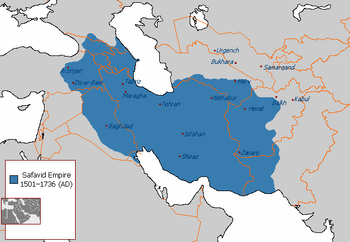Safavid dynasty facts for kids
Quick facts for kids
Safavid dynasty
|
|||||||||||||||||||||||||||||||
|---|---|---|---|---|---|---|---|---|---|---|---|---|---|---|---|---|---|---|---|---|---|---|---|---|---|---|---|---|---|---|---|
| 1501–1736 | |||||||||||||||||||||||||||||||
|
|
|||||||||||||||||||||||||||||||

The Safavid Empire under Shah Abbas the Great
|
|||||||||||||||||||||||||||||||
| Status | Empire | ||||||||||||||||||||||||||||||
| Capital | |||||||||||||||||||||||||||||||
| Common languages |
|
||||||||||||||||||||||||||||||
| Religion | Twelver Shiʻa Islam | ||||||||||||||||||||||||||||||
| Government | Monarchy | ||||||||||||||||||||||||||||||
| Shahanshah | |||||||||||||||||||||||||||||||
|
• 1501–1524
|
Ismail I (first) | ||||||||||||||||||||||||||||||
|
• 1732–1736
|
Abbas III (last) | ||||||||||||||||||||||||||||||
| Grand Vizier | |||||||||||||||||||||||||||||||
|
• 1501–?
|
Mohammad Zakariya Kujuji (first) | ||||||||||||||||||||||||||||||
|
• 1729–1736
|
Nader Qoli Beg (last) | ||||||||||||||||||||||||||||||
| Legislature | Council of State | ||||||||||||||||||||||||||||||
| History | |||||||||||||||||||||||||||||||
|
• Establishment of the Safavid order by Safi-ad-din Ardabili
|
1301 | ||||||||||||||||||||||||||||||
|
• Established
|
1501 | ||||||||||||||||||||||||||||||
|
• Hotaki Invasion
|
1722 | ||||||||||||||||||||||||||||||
|
• Reconquest under Nader Shah
|
1726–1729 | ||||||||||||||||||||||||||||||
|
• Disestablished
|
8 March 1736 | ||||||||||||||||||||||||||||||
|
• Nader Shah crowned
|
1 October 1736 | ||||||||||||||||||||||||||||||
| Currency | Tuman, Abbasi (incl. Abazi), Shahi.
|
||||||||||||||||||||||||||||||
|
|||||||||||||||||||||||||||||||
The Safavid dynasty was a very important ruling family in Iran. Many people see their rule as the start of modern Iranian history. The Safavid rulers, called shahs, led one of the powerful "gunpowder empires". It was one of the greatest Iranian empires after the Muslim conquest of Iran in the 7th century.
The Safavids made Twelver Shia Islam the official religion of their empire. This was a huge change in Muslim history.
The Safavid dynasty began with the Safavid order of Sufism. This group started in the city of Ardabil in the Azerbaijan region. The Safavids were an Iranian family with Kurdish roots. Over time, they married into other powerful families. These included Turkoman, Georgian, Circassian, and Pontic Greek nobles.
From Ardabil, the Safavids took control of parts of Greater Iran. They brought back the strong Iranian identity of the area. This made them the first native family since the Sasanian Empire to create a national state officially known as Iran.
The Safavids ruled from 1501 to 1722. They had a short return to power from 1729 to 1736. At their strongest, they controlled a huge area. This included all of modern Iran, Azerbaijan Republic, Bahrain, Armenia, and eastern Georgia. They also ruled parts of the North Caucasus, Iraq, Kuwait, and Afghanistan. Plus, they held parts of Turkey, Syria, Pakistan, Turkmenistan, and Uzbekistan.
Even after their rule ended in 1736, the Safavids left a lasting mark. They made Iran a strong economic center between the East and the West. They also created an effective government system. This system used "checks and balances" to keep power balanced. They were also known for their amazing buildings and support for fine arts. The Safavids also spread Twelver Islam in Iran. This faith is still important in parts of the Caucasus, Anatolia, and Mesopotamia today.
Contents
The Rise of the Safavid Empire
The Safavid Empire grew from a religious group. This group was called the Safavid Sufi order. It was founded by Safi-ad-din Ardabili in 1301. Over time, this religious group gained political power.
Important Leaders and Their Reigns
The Safavid Empire had several important leaders. These leaders, called Shahs, helped shape the empire.
Shah Ismail I: The Founder
Ismail I was the first Safavid Shah. He ruled from 1501 to 1524. Shah Ismail I was very important because he founded the empire. He also made Twelver Shia Islam the official religion. This was a big step for Iran.
Shah Abbas the Great: A Golden Age
Shah Abbas ruled from 1588 to 1629. He is often called "the Great" because he made the empire very strong. Under his rule, the Safavid Empire reached its largest size. He also moved the capital to Isfahan, which became a beautiful city.
Safavid Capitals Over Time
The Safavid Empire had different capital cities during its history.
- Tabriz was the first capital from 1501 to 1555.
- Qazvin became the capital from 1555 to 1598.
- Isfahan was the final capital from 1598 to 1736.
Culture and Achievements
The Safavid dynasty was known for its rich culture. They supported many forms of art and learning.
Art and Architecture
The Safavids built many beautiful mosques, palaces, and bridges. Their architecture is famous for its colorful tiles and detailed designs. They also supported painting, calligraphy, and carpet weaving. Safavid art is still admired today.
Religion and Society
The Safavids made Twelver Shia Islam the state religion. This helped create a strong national identity in Iran. They also had a system of government with different parts. This helped keep power balanced.
Decline and End of the Empire
The Safavid Empire faced challenges over time. These challenges led to its decline.
Hotaki Invasion and Fall
In 1722, the Hotaki Afghans invaded the empire. They captured the capital, Isfahan. This led to the end of the main Safavid rule.
Brief Restoration and Final End
The Safavid rule was briefly restored from 1729 to 1736. However, Nader Shah eventually took full control. He was crowned in 1736, marking the final end of the Safavid dynasty.
See also
 In Spanish: Imperio safávida para niños
In Spanish: Imperio safávida para niños



